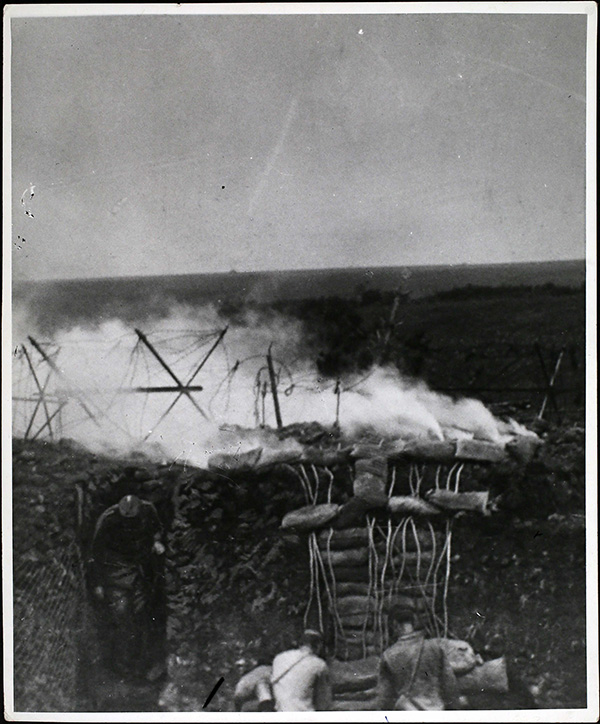In point of fact, the use of gas in the Great War was far less effective and deadly than it was made out to be. According to ‘The Great War Handbook’ by Geoff Bridger, despite a recorded 186,000 British soldiers suffering from gas poisoning, just 5,899 men actually died from this affliction. Why, then, did the soldiers so fear the ominous clouds that swept the battlefields?
Firstly, the use of gas was new in warfare, so nobody knew quite what to expect, making it difficult to combat the creeping threat. Although non-lethal forms of gas, such as sneezing gas and tear gas, had in fact been used at the Western Front as early as 1914, the first potentially lethal chemical released was Chlorine gas, dispersed by the Germans at the Second Battle of Ypres, on 22nd April 1915. Released from 5,700 cylinders, the curious yellowy-green cloud floated slowly towards the French and Algerian trenches and dugouts and, being heavier than oxygen, sank down into them.
The unfortunate defenders fled, coughing and clutching their throats, and complete victory, as Philip Warner explains in his ‘World War One: a Chronological Narrative’, was only prevented by two things. The Germans, not having expected such rapid success and not being entirely sure how long the poison would linger or how effective their gas masks might be, halted after just 2 miles, despite the Allies having retreated 4, and failed to take advantage of the temporary gap in the front line. Additionally, the Canadians and Yorkshire territorials in the next sector came to the aid of their fellow soldiers. Luckily, a Canadian chemist speedily identified the gas and advised his mates to hold urine-soaked handkerchiefs to their faces; the alkaline fluid neutralised the harmful acid, keeping the men relatively safe.
Eventually protection against the gas grew more advanced – from the simple goggles with cotton pads soaked in neutralising chemical solutions came a gas helmet with a hood (treated with anti-gas solution), breathing tube and eyeholes, developed by Newfoundland scientist Cluny Macpherson. As described in Gary Sheffield’s ‘The First World War in 100 Objects’, in 1916 the ‘Small Box Respirator’, conceived by British research chemist E. F. Harrison, became standard issue. This was a canvas mask, attached to a rubber hose, which fed into a filter tube. The latter decontaminated and filtered the air. While effective, this device was rather temperamental and, where gas was colourless, could often be pulled on too late. Still, they certainly cut fatalities when used properly.
Even before the developments in protection, just 3% of the resulting casualties died. However, the second reason gas was so feared was that the effects on survivors, though mostly temporary and reversible, could be terrible. It is widely believed that Hitler’s experiences of being briefly blinded and hospitalised after a gas attack in World War One led to his steady refusal to use chemical weapons on the World War Two battlefields. Burning eyes and blindness, a struggle to breath so immense that the soldier’s mouth often filled with blood, burning lungs, vomiting, and in the case of the hard-to-shift mustard gas, nasty burns on the lungs and skin that were very slow to heal… it’s no wonder than any soldier who had experienced these symptoms dreaded, almost more than death itself, going through that again. In medical centres, often men who had had their legs amputated remained resolutely silent once they were back on the wards, while men suffering from gas injuries could not help screaming horribly. A less detrimental side-effect of gas, though still serious, was that any metallic equipment exposed to the acidic mist rusted instantly, rendering it unfit for use. All vegetation in exposed regions also withered and died.
The third reason was that gas was an extremely unpredictable substance. When the British retaliated for the Germans’ uncivilised behaviour by launching their own cloud of chlorine gas at the Battle of Loos on 25th September, their attack generated mixed results. Richard Holmes explains in his ‘The First World War in Photographs’ that, while in the south near Loos the Germans were overrun and driven out of the trenches, but in the north disaster struck. The wind changed and the gas blew straight back over the British trenches, crippling the British soldiers. Similar wind changes also afflicted the German Army when it tried to make use of chemical warfare, also near Loos, on 27th April 1916. In both instances, the would-be attackers ran backwards from their trenches, only be caught in enemy artillery fire and decimated. In the best-case scenario, where everything went as planned, attackers still had to wear gas masks and were thus hindered, as the eyepieces tended to mist up and the effort of breathing through a respirator swiftly brought on fatigue.
Basically, fatal or not, chemical warfare (though often effective, especially when delivered by shells mixed with explosives and fog that disguised its approach) was nasty, and rightly feared. The psychological wounds inflicted on casualties often took much longer than the physical to heal, and besides the total deaths inflicted by this method were certainly underestimated. As Geoff Bridger explains in his ‘The Great War Handbook’, many of the battlefield fatalities were simply recorded as ‘killed in action’, and therefore never accredited to gas. As well, years after the war had finished and the young men of Britain were supposedly out of danger, scores died young thanks to the heavy damage inflicted on their lungs while the conflict raged.


